Annotated Bibliography on Current Trends in Primary Health Care
VerifiedAdded on 2023/01/20
|11
|3040
|100
Annotated Bibliography
AI Summary
This annotated bibliography examines several key studies on primary health care. It begins with an analysis of a study evaluating Brazilian primary health care from the users' perspective, focusing on accessibility, continuity, and acceptability. The bibliography then reviews a systematic review of primary health care delivery models in rural and remote Australia, identifying challenges and proposing solutions. Following this, it evaluates a study assessing the quality of care for senior citizens within the primary health care system in Brazil, and suggests improvements. The bibliography also includes an examination of a study on how an urban Aboriginal and Torres Strait Islander primary health care service improved access to mental health care. Finally, it evaluates the delivery of emotional and social well-being services to families of young Indigenous children attending primary care centers. The bibliography critically assesses the quality, methodology, and significance of each article, providing a comprehensive overview of current research in the field.
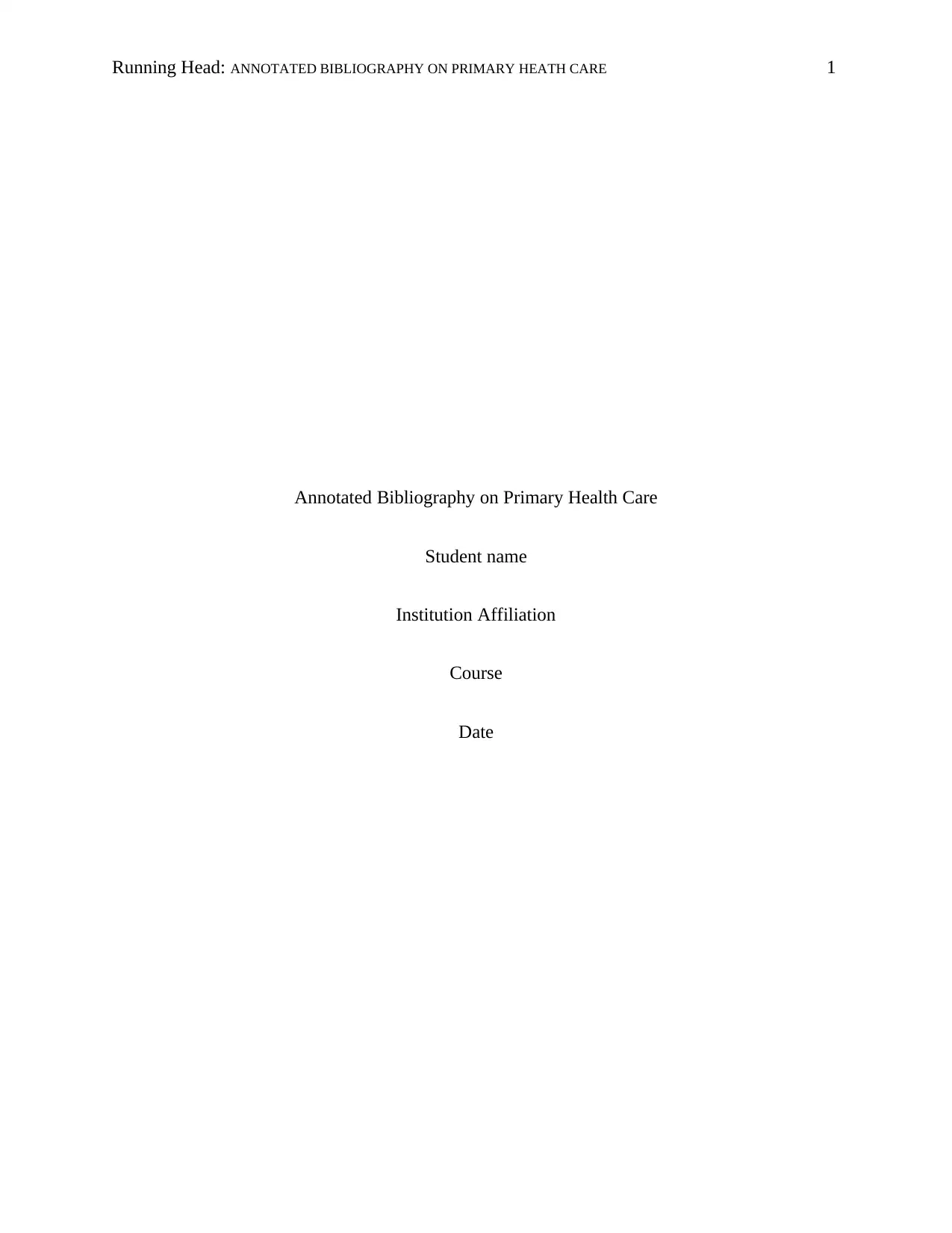
Running Head: ANNOTATED BIBLIOGRAPHY ON PRIMARY HEATH CARE 1
Annotated Bibliography on Primary Health Care
Student name
Institution Affiliation
Course
Date
Annotated Bibliography on Primary Health Care
Student name
Institution Affiliation
Course
Date
Paraphrase This Document
Need a fresh take? Get an instant paraphrase of this document with our AI Paraphraser
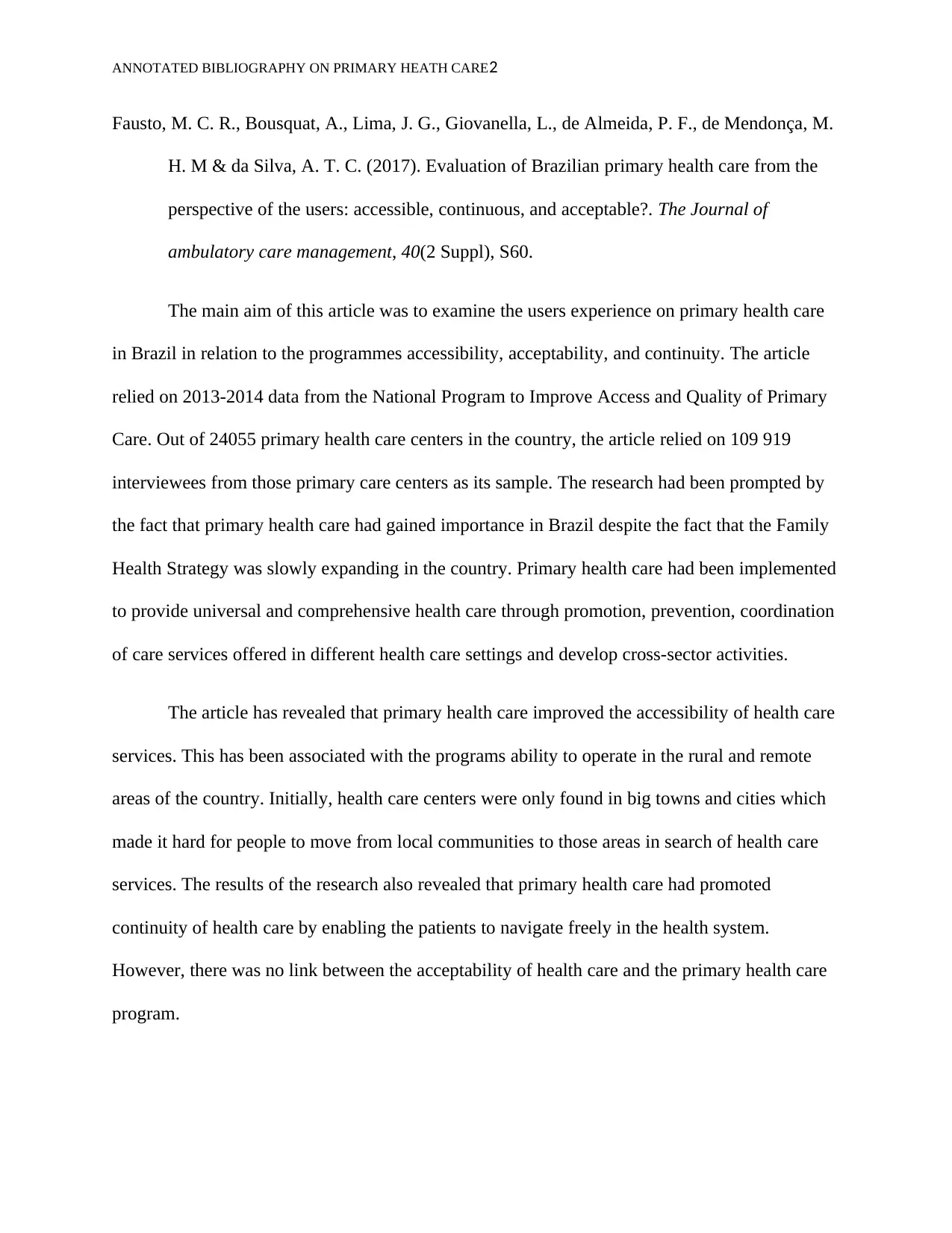
ANNOTATED BIBLIOGRAPHY ON PRIMARY HEATH CARE2
Fausto, M. C. R., Bousquat, A., Lima, J. G., Giovanella, L., de Almeida, P. F., de Mendonça, M.
H. M & da Silva, A. T. C. (2017). Evaluation of Brazilian primary health care from the
perspective of the users: accessible, continuous, and acceptable?. The Journal of
ambulatory care management, 40(2 Suppl), S60.
The main aim of this article was to examine the users experience on primary health care
in Brazil in relation to the programmes accessibility, acceptability, and continuity. The article
relied on 2013-2014 data from the National Program to Improve Access and Quality of Primary
Care. Out of 24055 primary health care centers in the country, the article relied on 109 919
interviewees from those primary care centers as its sample. The research had been prompted by
the fact that primary health care had gained importance in Brazil despite the fact that the Family
Health Strategy was slowly expanding in the country. Primary health care had been implemented
to provide universal and comprehensive health care through promotion, prevention, coordination
of care services offered in different health care settings and develop cross-sector activities.
The article has revealed that primary health care improved the accessibility of health care
services. This has been associated with the programs ability to operate in the rural and remote
areas of the country. Initially, health care centers were only found in big towns and cities which
made it hard for people to move from local communities to those areas in search of health care
services. The results of the research also revealed that primary health care had promoted
continuity of health care by enabling the patients to navigate freely in the health system.
However, there was no link between the acceptability of health care and the primary health care
program.
Fausto, M. C. R., Bousquat, A., Lima, J. G., Giovanella, L., de Almeida, P. F., de Mendonça, M.
H. M & da Silva, A. T. C. (2017). Evaluation of Brazilian primary health care from the
perspective of the users: accessible, continuous, and acceptable?. The Journal of
ambulatory care management, 40(2 Suppl), S60.
The main aim of this article was to examine the users experience on primary health care
in Brazil in relation to the programmes accessibility, acceptability, and continuity. The article
relied on 2013-2014 data from the National Program to Improve Access and Quality of Primary
Care. Out of 24055 primary health care centers in the country, the article relied on 109 919
interviewees from those primary care centers as its sample. The research had been prompted by
the fact that primary health care had gained importance in Brazil despite the fact that the Family
Health Strategy was slowly expanding in the country. Primary health care had been implemented
to provide universal and comprehensive health care through promotion, prevention, coordination
of care services offered in different health care settings and develop cross-sector activities.
The article has revealed that primary health care improved the accessibility of health care
services. This has been associated with the programs ability to operate in the rural and remote
areas of the country. Initially, health care centers were only found in big towns and cities which
made it hard for people to move from local communities to those areas in search of health care
services. The results of the research also revealed that primary health care had promoted
continuity of health care by enabling the patients to navigate freely in the health system.
However, there was no link between the acceptability of health care and the primary health care
program.
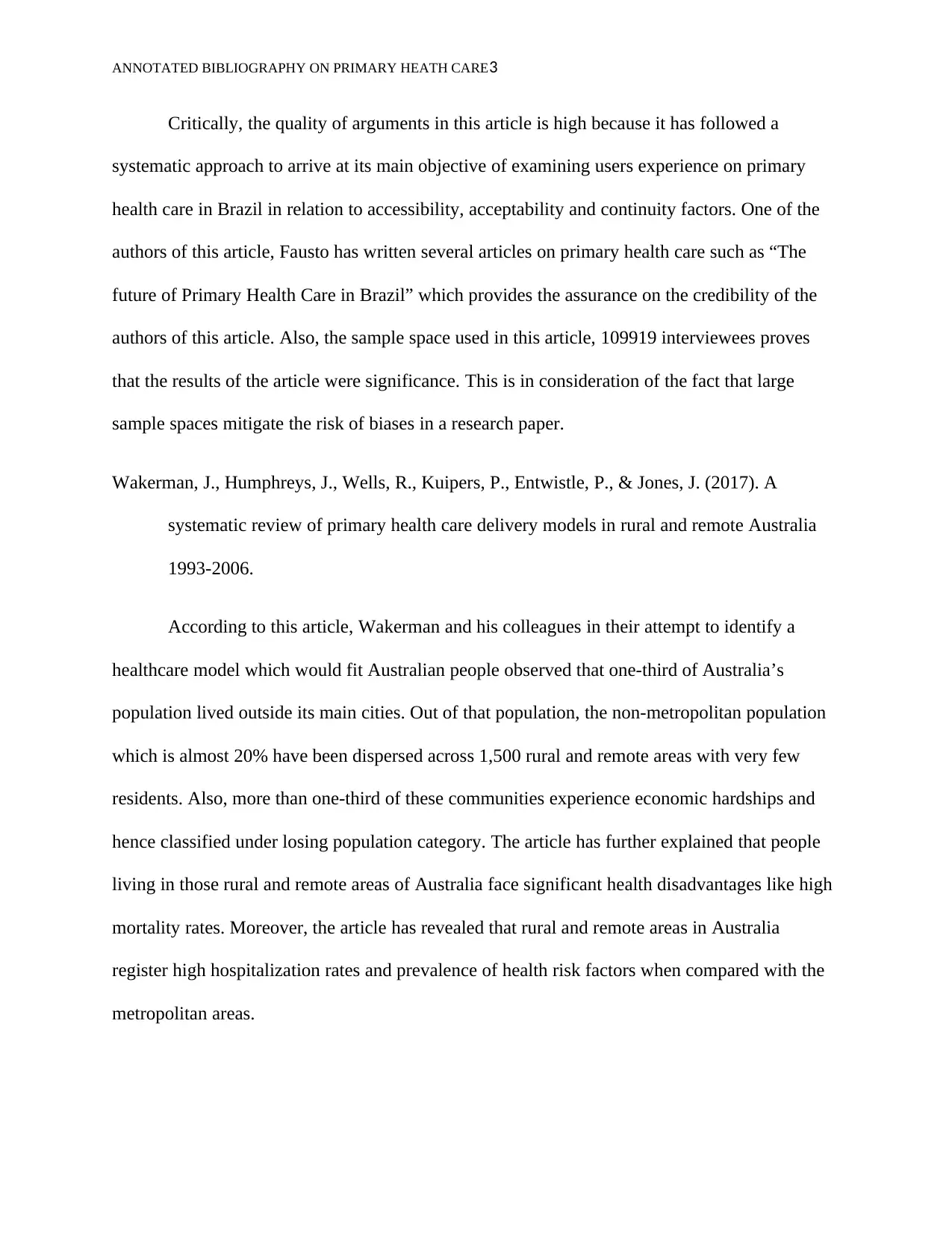
ANNOTATED BIBLIOGRAPHY ON PRIMARY HEATH CARE3
Critically, the quality of arguments in this article is high because it has followed a
systematic approach to arrive at its main objective of examining users experience on primary
health care in Brazil in relation to accessibility, acceptability and continuity factors. One of the
authors of this article, Fausto has written several articles on primary health care such as “The
future of Primary Health Care in Brazil” which provides the assurance on the credibility of the
authors of this article. Also, the sample space used in this article, 109919 interviewees proves
that the results of the article were significance. This is in consideration of the fact that large
sample spaces mitigate the risk of biases in a research paper.
Wakerman, J., Humphreys, J., Wells, R., Kuipers, P., Entwistle, P., & Jones, J. (2017). A
systematic review of primary health care delivery models in rural and remote Australia
1993-2006.
According to this article, Wakerman and his colleagues in their attempt to identify a
healthcare model which would fit Australian people observed that one-third of Australia’s
population lived outside its main cities. Out of that population, the non-metropolitan population
which is almost 20% have been dispersed across 1,500 rural and remote areas with very few
residents. Also, more than one-third of these communities experience economic hardships and
hence classified under losing population category. The article has further explained that people
living in those rural and remote areas of Australia face significant health disadvantages like high
mortality rates. Moreover, the article has revealed that rural and remote areas in Australia
register high hospitalization rates and prevalence of health risk factors when compared with the
metropolitan areas.
Critically, the quality of arguments in this article is high because it has followed a
systematic approach to arrive at its main objective of examining users experience on primary
health care in Brazil in relation to accessibility, acceptability and continuity factors. One of the
authors of this article, Fausto has written several articles on primary health care such as “The
future of Primary Health Care in Brazil” which provides the assurance on the credibility of the
authors of this article. Also, the sample space used in this article, 109919 interviewees proves
that the results of the article were significance. This is in consideration of the fact that large
sample spaces mitigate the risk of biases in a research paper.
Wakerman, J., Humphreys, J., Wells, R., Kuipers, P., Entwistle, P., & Jones, J. (2017). A
systematic review of primary health care delivery models in rural and remote Australia
1993-2006.
According to this article, Wakerman and his colleagues in their attempt to identify a
healthcare model which would fit Australian people observed that one-third of Australia’s
population lived outside its main cities. Out of that population, the non-metropolitan population
which is almost 20% have been dispersed across 1,500 rural and remote areas with very few
residents. Also, more than one-third of these communities experience economic hardships and
hence classified under losing population category. The article has further explained that people
living in those rural and remote areas of Australia face significant health disadvantages like high
mortality rates. Moreover, the article has revealed that rural and remote areas in Australia
register high hospitalization rates and prevalence of health risk factors when compared with the
metropolitan areas.
⊘ This is a preview!⊘
Do you want full access?
Subscribe today to unlock all pages.

Trusted by 1+ million students worldwide
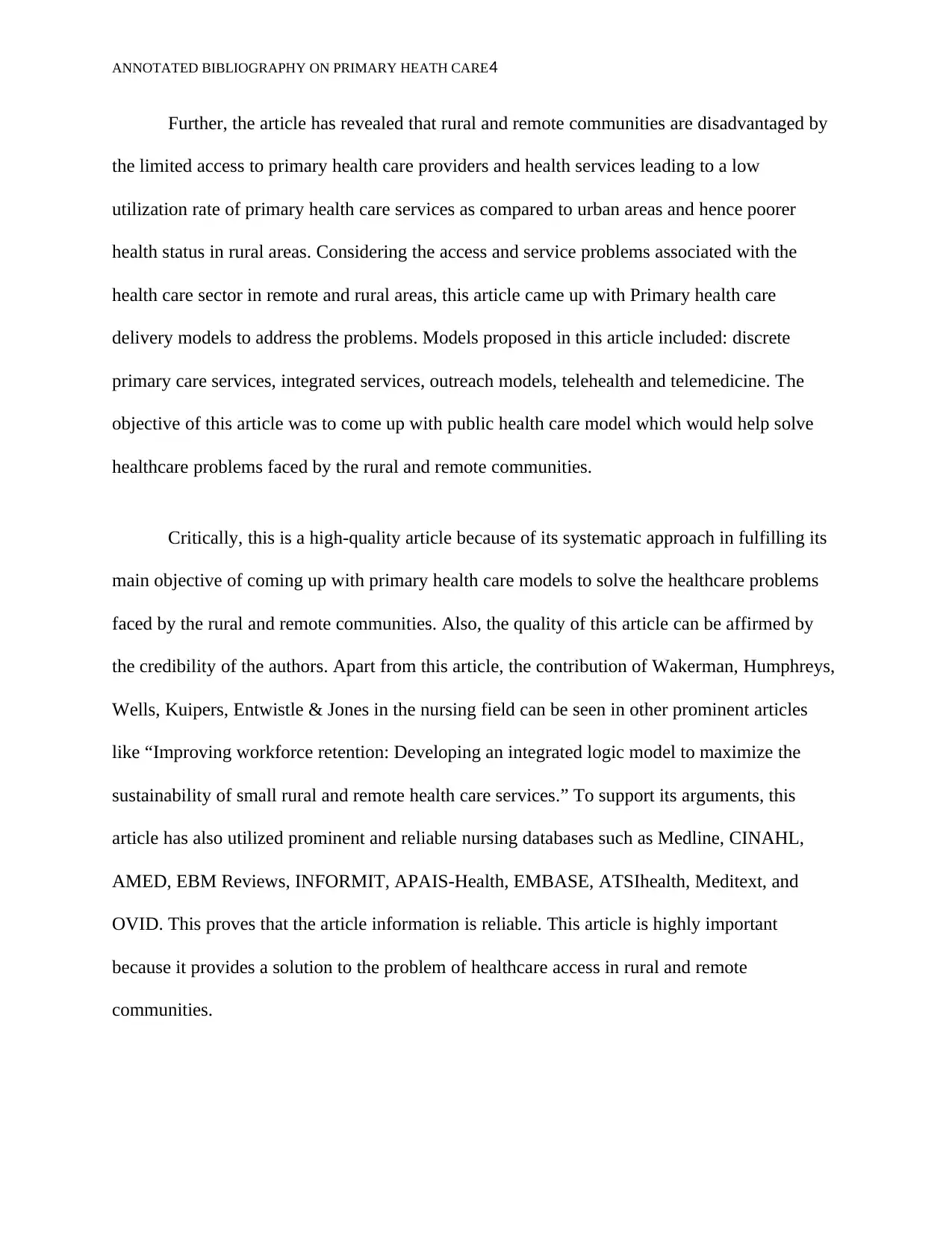
ANNOTATED BIBLIOGRAPHY ON PRIMARY HEATH CARE4
Further, the article has revealed that rural and remote communities are disadvantaged by
the limited access to primary health care providers and health services leading to a low
utilization rate of primary health care services as compared to urban areas and hence poorer
health status in rural areas. Considering the access and service problems associated with the
health care sector in remote and rural areas, this article came up with Primary health care
delivery models to address the problems. Models proposed in this article included: discrete
primary care services, integrated services, outreach models, telehealth and telemedicine. The
objective of this article was to come up with public health care model which would help solve
healthcare problems faced by the rural and remote communities.
Critically, this is a high-quality article because of its systematic approach in fulfilling its
main objective of coming up with primary health care models to solve the healthcare problems
faced by the rural and remote communities. Also, the quality of this article can be affirmed by
the credibility of the authors. Apart from this article, the contribution of Wakerman, Humphreys,
Wells, Kuipers, Entwistle & Jones in the nursing field can be seen in other prominent articles
like “Improving workforce retention: Developing an integrated logic model to maximize the
sustainability of small rural and remote health care services.” To support its arguments, this
article has also utilized prominent and reliable nursing databases such as Medline, CINAHL,
AMED, EBM Reviews, INFORMIT, APAIS-Health, EMBASE, ATSIhealth, Meditext, and
OVID. This proves that the article information is reliable. This article is highly important
because it provides a solution to the problem of healthcare access in rural and remote
communities.
Further, the article has revealed that rural and remote communities are disadvantaged by
the limited access to primary health care providers and health services leading to a low
utilization rate of primary health care services as compared to urban areas and hence poorer
health status in rural areas. Considering the access and service problems associated with the
health care sector in remote and rural areas, this article came up with Primary health care
delivery models to address the problems. Models proposed in this article included: discrete
primary care services, integrated services, outreach models, telehealth and telemedicine. The
objective of this article was to come up with public health care model which would help solve
healthcare problems faced by the rural and remote communities.
Critically, this is a high-quality article because of its systematic approach in fulfilling its
main objective of coming up with primary health care models to solve the healthcare problems
faced by the rural and remote communities. Also, the quality of this article can be affirmed by
the credibility of the authors. Apart from this article, the contribution of Wakerman, Humphreys,
Wells, Kuipers, Entwistle & Jones in the nursing field can be seen in other prominent articles
like “Improving workforce retention: Developing an integrated logic model to maximize the
sustainability of small rural and remote health care services.” To support its arguments, this
article has also utilized prominent and reliable nursing databases such as Medline, CINAHL,
AMED, EBM Reviews, INFORMIT, APAIS-Health, EMBASE, ATSIhealth, Meditext, and
OVID. This proves that the article information is reliable. This article is highly important
because it provides a solution to the problem of healthcare access in rural and remote
communities.
Paraphrase This Document
Need a fresh take? Get an instant paraphrase of this document with our AI Paraphraser
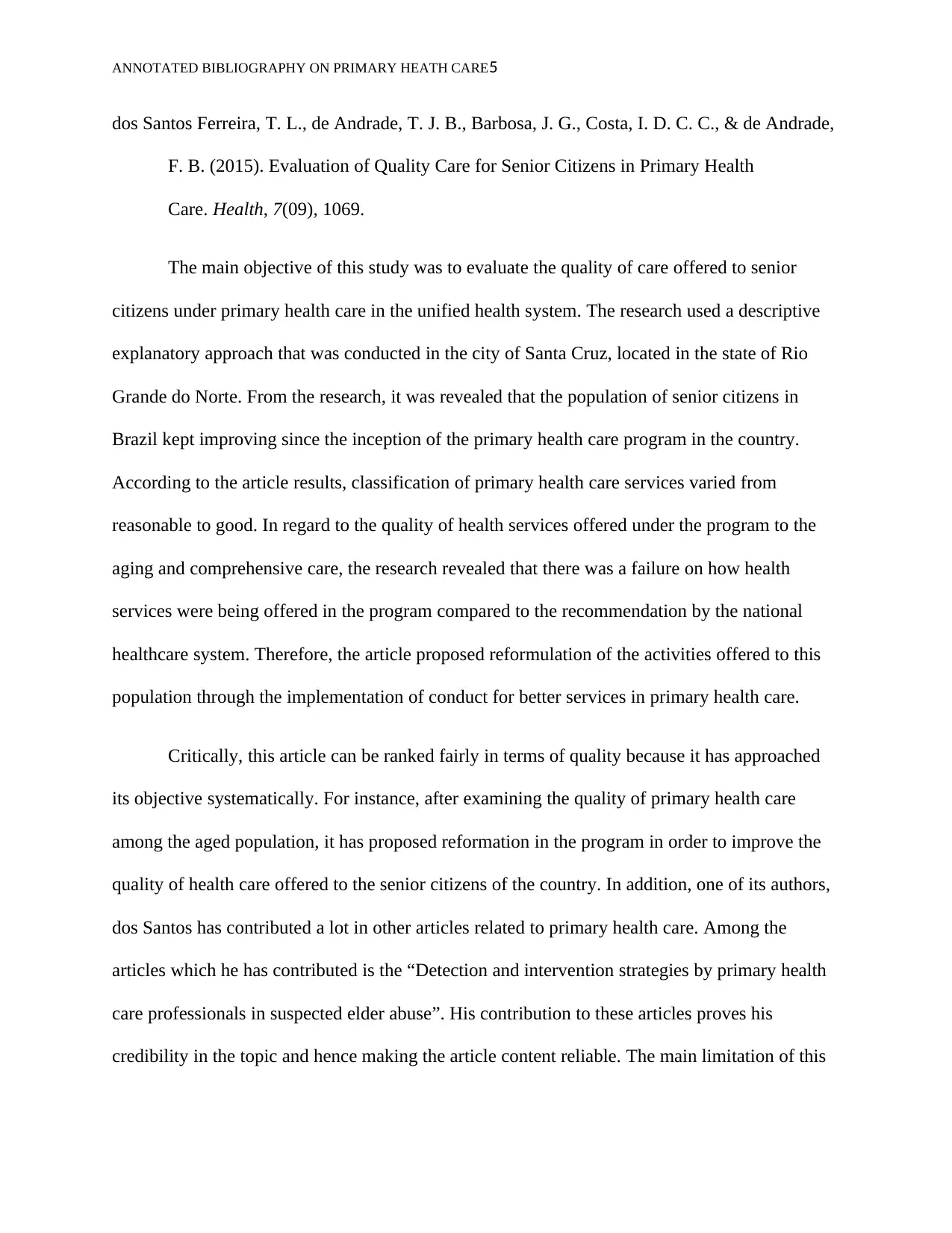
ANNOTATED BIBLIOGRAPHY ON PRIMARY HEATH CARE5
dos Santos Ferreira, T. L., de Andrade, T. J. B., Barbosa, J. G., Costa, I. D. C. C., & de Andrade,
F. B. (2015). Evaluation of Quality Care for Senior Citizens in Primary Health
Care. Health, 7(09), 1069.
The main objective of this study was to evaluate the quality of care offered to senior
citizens under primary health care in the unified health system. The research used a descriptive
explanatory approach that was conducted in the city of Santa Cruz, located in the state of Rio
Grande do Norte. From the research, it was revealed that the population of senior citizens in
Brazil kept improving since the inception of the primary health care program in the country.
According to the article results, classification of primary health care services varied from
reasonable to good. In regard to the quality of health services offered under the program to the
aging and comprehensive care, the research revealed that there was a failure on how health
services were being offered in the program compared to the recommendation by the national
healthcare system. Therefore, the article proposed reformulation of the activities offered to this
population through the implementation of conduct for better services in primary health care.
Critically, this article can be ranked fairly in terms of quality because it has approached
its objective systematically. For instance, after examining the quality of primary health care
among the aged population, it has proposed reformation in the program in order to improve the
quality of health care offered to the senior citizens of the country. In addition, one of its authors,
dos Santos has contributed a lot in other articles related to primary health care. Among the
articles which he has contributed is the “Detection and intervention strategies by primary health
care professionals in suspected elder abuse”. His contribution to these articles proves his
credibility in the topic and hence making the article content reliable. The main limitation of this
dos Santos Ferreira, T. L., de Andrade, T. J. B., Barbosa, J. G., Costa, I. D. C. C., & de Andrade,
F. B. (2015). Evaluation of Quality Care for Senior Citizens in Primary Health
Care. Health, 7(09), 1069.
The main objective of this study was to evaluate the quality of care offered to senior
citizens under primary health care in the unified health system. The research used a descriptive
explanatory approach that was conducted in the city of Santa Cruz, located in the state of Rio
Grande do Norte. From the research, it was revealed that the population of senior citizens in
Brazil kept improving since the inception of the primary health care program in the country.
According to the article results, classification of primary health care services varied from
reasonable to good. In regard to the quality of health services offered under the program to the
aging and comprehensive care, the research revealed that there was a failure on how health
services were being offered in the program compared to the recommendation by the national
healthcare system. Therefore, the article proposed reformulation of the activities offered to this
population through the implementation of conduct for better services in primary health care.
Critically, this article can be ranked fairly in terms of quality because it has approached
its objective systematically. For instance, after examining the quality of primary health care
among the aged population, it has proposed reformation in the program in order to improve the
quality of health care offered to the senior citizens of the country. In addition, one of its authors,
dos Santos has contributed a lot in other articles related to primary health care. Among the
articles which he has contributed is the “Detection and intervention strategies by primary health
care professionals in suspected elder abuse”. His contribution to these articles proves his
credibility in the topic and hence making the article content reliable. The main limitation of this
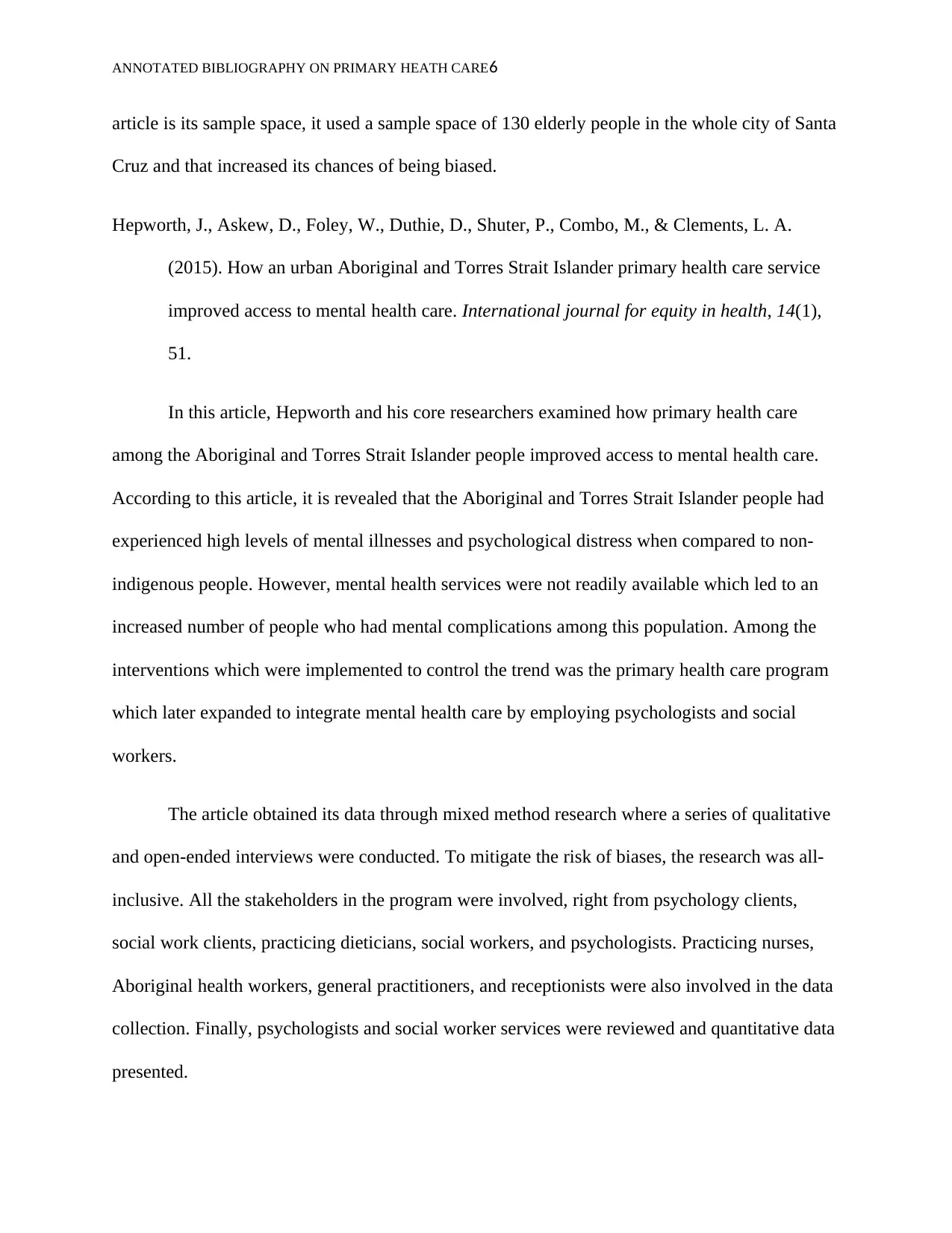
ANNOTATED BIBLIOGRAPHY ON PRIMARY HEATH CARE6
article is its sample space, it used a sample space of 130 elderly people in the whole city of Santa
Cruz and that increased its chances of being biased.
Hepworth, J., Askew, D., Foley, W., Duthie, D., Shuter, P., Combo, M., & Clements, L. A.
(2015). How an urban Aboriginal and Torres Strait Islander primary health care service
improved access to mental health care. International journal for equity in health, 14(1),
51.
In this article, Hepworth and his core researchers examined how primary health care
among the Aboriginal and Torres Strait Islander people improved access to mental health care.
According to this article, it is revealed that the Aboriginal and Torres Strait Islander people had
experienced high levels of mental illnesses and psychological distress when compared to non-
indigenous people. However, mental health services were not readily available which led to an
increased number of people who had mental complications among this population. Among the
interventions which were implemented to control the trend was the primary health care program
which later expanded to integrate mental health care by employing psychologists and social
workers.
The article obtained its data through mixed method research where a series of qualitative
and open-ended interviews were conducted. To mitigate the risk of biases, the research was all-
inclusive. All the stakeholders in the program were involved, right from psychology clients,
social work clients, practicing dieticians, social workers, and psychologists. Practicing nurses,
Aboriginal health workers, general practitioners, and receptionists were also involved in the data
collection. Finally, psychologists and social worker services were reviewed and quantitative data
presented.
article is its sample space, it used a sample space of 130 elderly people in the whole city of Santa
Cruz and that increased its chances of being biased.
Hepworth, J., Askew, D., Foley, W., Duthie, D., Shuter, P., Combo, M., & Clements, L. A.
(2015). How an urban Aboriginal and Torres Strait Islander primary health care service
improved access to mental health care. International journal for equity in health, 14(1),
51.
In this article, Hepworth and his core researchers examined how primary health care
among the Aboriginal and Torres Strait Islander people improved access to mental health care.
According to this article, it is revealed that the Aboriginal and Torres Strait Islander people had
experienced high levels of mental illnesses and psychological distress when compared to non-
indigenous people. However, mental health services were not readily available which led to an
increased number of people who had mental complications among this population. Among the
interventions which were implemented to control the trend was the primary health care program
which later expanded to integrate mental health care by employing psychologists and social
workers.
The article obtained its data through mixed method research where a series of qualitative
and open-ended interviews were conducted. To mitigate the risk of biases, the research was all-
inclusive. All the stakeholders in the program were involved, right from psychology clients,
social work clients, practicing dieticians, social workers, and psychologists. Practicing nurses,
Aboriginal health workers, general practitioners, and receptionists were also involved in the data
collection. Finally, psychologists and social worker services were reviewed and quantitative data
presented.
⊘ This is a preview!⊘
Do you want full access?
Subscribe today to unlock all pages.

Trusted by 1+ million students worldwide
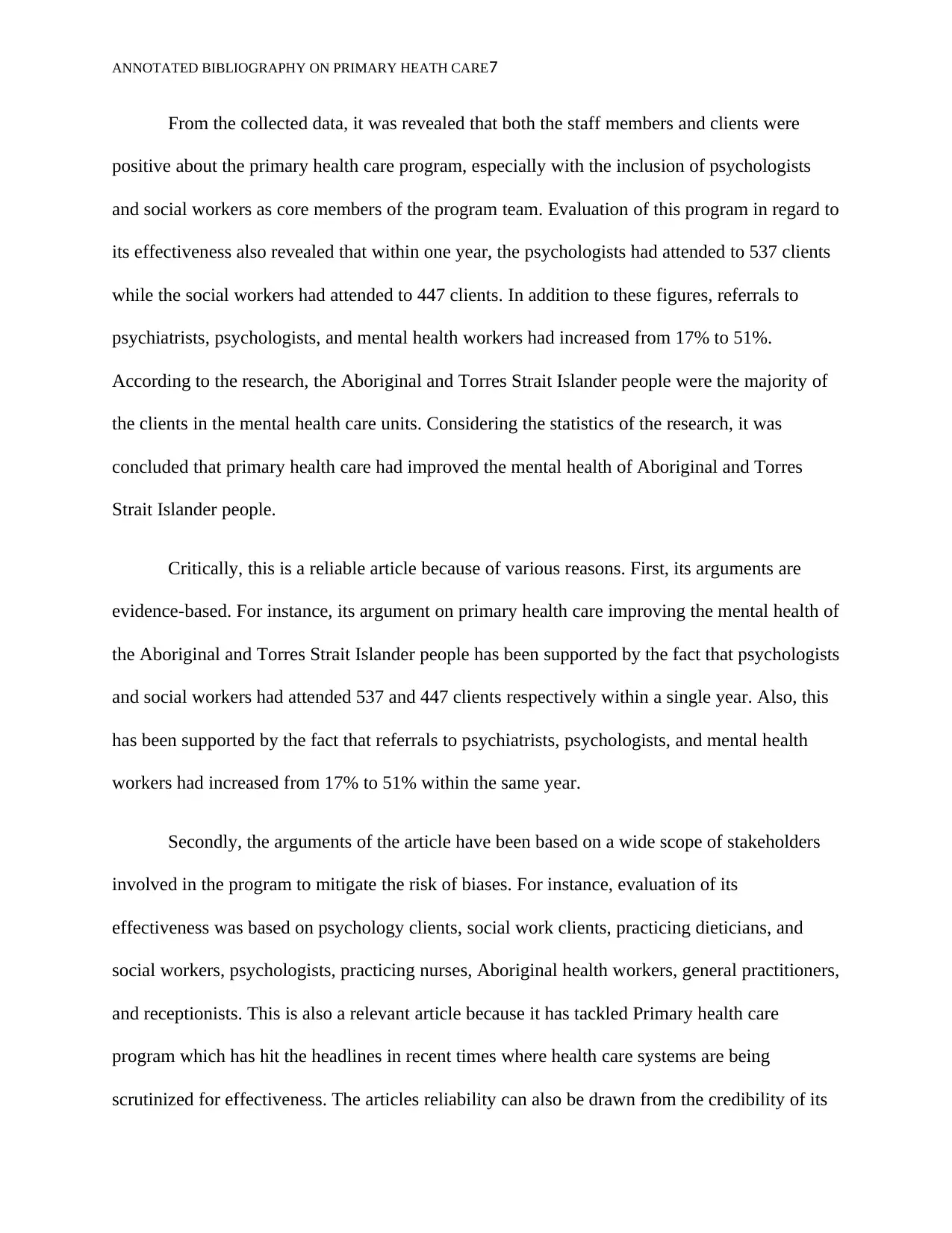
ANNOTATED BIBLIOGRAPHY ON PRIMARY HEATH CARE7
From the collected data, it was revealed that both the staff members and clients were
positive about the primary health care program, especially with the inclusion of psychologists
and social workers as core members of the program team. Evaluation of this program in regard to
its effectiveness also revealed that within one year, the psychologists had attended to 537 clients
while the social workers had attended to 447 clients. In addition to these figures, referrals to
psychiatrists, psychologists, and mental health workers had increased from 17% to 51%.
According to the research, the Aboriginal and Torres Strait Islander people were the majority of
the clients in the mental health care units. Considering the statistics of the research, it was
concluded that primary health care had improved the mental health of Aboriginal and Torres
Strait Islander people.
Critically, this is a reliable article because of various reasons. First, its arguments are
evidence-based. For instance, its argument on primary health care improving the mental health of
the Aboriginal and Torres Strait Islander people has been supported by the fact that psychologists
and social workers had attended 537 and 447 clients respectively within a single year. Also, this
has been supported by the fact that referrals to psychiatrists, psychologists, and mental health
workers had increased from 17% to 51% within the same year.
Secondly, the arguments of the article have been based on a wide scope of stakeholders
involved in the program to mitigate the risk of biases. For instance, evaluation of its
effectiveness was based on psychology clients, social work clients, practicing dieticians, and
social workers, psychologists, practicing nurses, Aboriginal health workers, general practitioners,
and receptionists. This is also a relevant article because it has tackled Primary health care
program which has hit the headlines in recent times where health care systems are being
scrutinized for effectiveness. The articles reliability can also be drawn from the credibility of its
From the collected data, it was revealed that both the staff members and clients were
positive about the primary health care program, especially with the inclusion of psychologists
and social workers as core members of the program team. Evaluation of this program in regard to
its effectiveness also revealed that within one year, the psychologists had attended to 537 clients
while the social workers had attended to 447 clients. In addition to these figures, referrals to
psychiatrists, psychologists, and mental health workers had increased from 17% to 51%.
According to the research, the Aboriginal and Torres Strait Islander people were the majority of
the clients in the mental health care units. Considering the statistics of the research, it was
concluded that primary health care had improved the mental health of Aboriginal and Torres
Strait Islander people.
Critically, this is a reliable article because of various reasons. First, its arguments are
evidence-based. For instance, its argument on primary health care improving the mental health of
the Aboriginal and Torres Strait Islander people has been supported by the fact that psychologists
and social workers had attended 537 and 447 clients respectively within a single year. Also, this
has been supported by the fact that referrals to psychiatrists, psychologists, and mental health
workers had increased from 17% to 51% within the same year.
Secondly, the arguments of the article have been based on a wide scope of stakeholders
involved in the program to mitigate the risk of biases. For instance, evaluation of its
effectiveness was based on psychology clients, social work clients, practicing dieticians, and
social workers, psychologists, practicing nurses, Aboriginal health workers, general practitioners,
and receptionists. This is also a relevant article because it has tackled Primary health care
program which has hit the headlines in recent times where health care systems are being
scrutinized for effectiveness. The articles reliability can also be drawn from the credibility of its
Paraphrase This Document
Need a fresh take? Get an instant paraphrase of this document with our AI Paraphraser
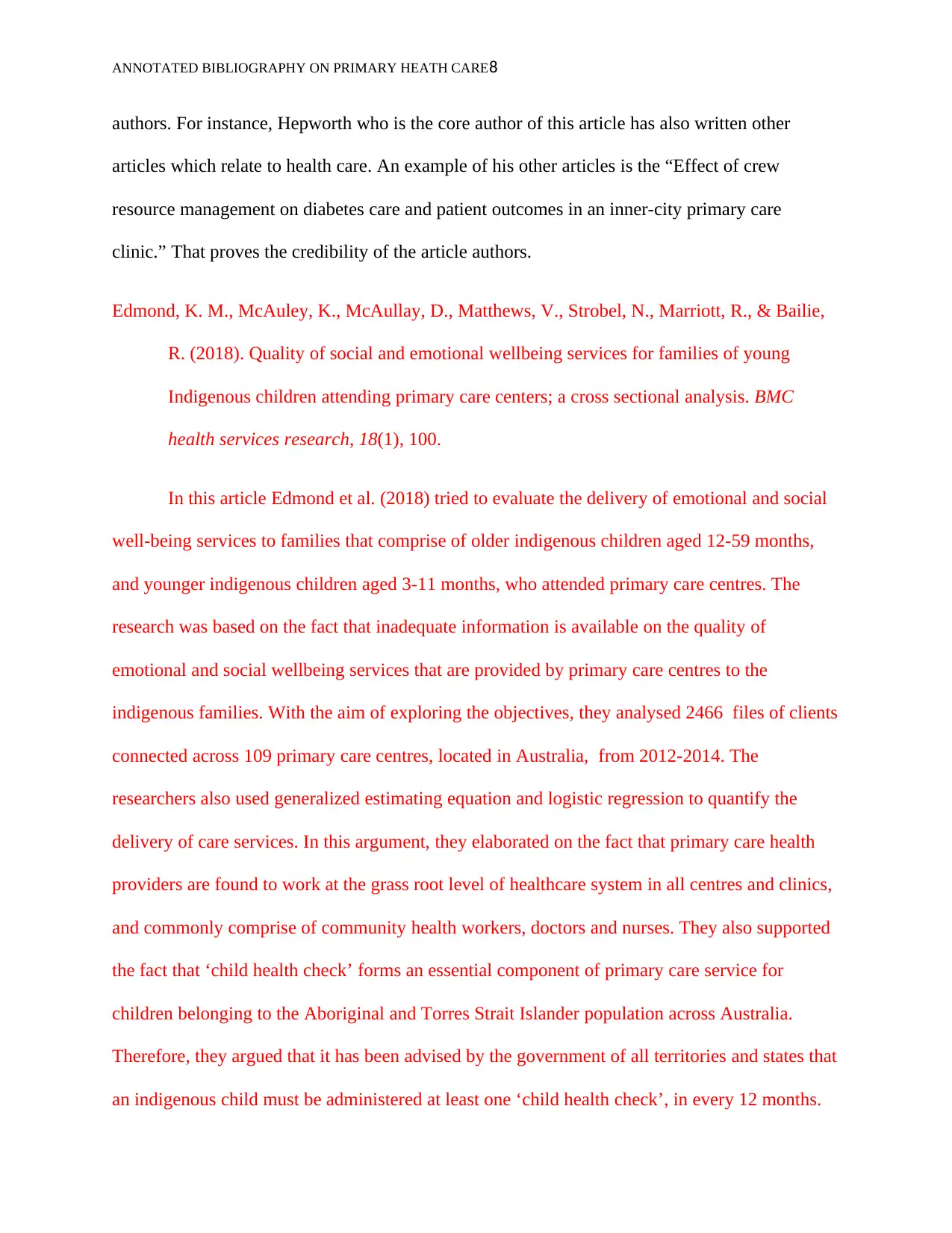
ANNOTATED BIBLIOGRAPHY ON PRIMARY HEATH CARE8
authors. For instance, Hepworth who is the core author of this article has also written other
articles which relate to health care. An example of his other articles is the “Effect of crew
resource management on diabetes care and patient outcomes in an inner-city primary care
clinic.” That proves the credibility of the article authors.
Edmond, K. M., McAuley, K., McAullay, D., Matthews, V., Strobel, N., Marriott, R., & Bailie,
R. (2018). Quality of social and emotional wellbeing services for families of young
Indigenous children attending primary care centers; a cross sectional analysis. BMC
health services research, 18(1), 100.
In this article Edmond et al. (2018) tried to evaluate the delivery of emotional and social
well-being services to families that comprise of older indigenous children aged 12-59 months,
and younger indigenous children aged 3-11 months, who attended primary care centres. The
research was based on the fact that inadequate information is available on the quality of
emotional and social wellbeing services that are provided by primary care centres to the
indigenous families. With the aim of exploring the objectives, they analysed 2466 files of clients
connected across 109 primary care centres, located in Australia, from 2012-2014. The
researchers also used generalized estimating equation and logistic regression to quantify the
delivery of care services. In this argument, they elaborated on the fact that primary care health
providers are found to work at the grass root level of healthcare system in all centres and clinics,
and commonly comprise of community health workers, doctors and nurses. They also supported
the fact that ‘child health check’ forms an essential component of primary care service for
children belonging to the Aboriginal and Torres Strait Islander population across Australia.
Therefore, they argued that it has been advised by the government of all territories and states that
an indigenous child must be administered at least one ‘child health check’, in every 12 months.
authors. For instance, Hepworth who is the core author of this article has also written other
articles which relate to health care. An example of his other articles is the “Effect of crew
resource management on diabetes care and patient outcomes in an inner-city primary care
clinic.” That proves the credibility of the article authors.
Edmond, K. M., McAuley, K., McAullay, D., Matthews, V., Strobel, N., Marriott, R., & Bailie,
R. (2018). Quality of social and emotional wellbeing services for families of young
Indigenous children attending primary care centers; a cross sectional analysis. BMC
health services research, 18(1), 100.
In this article Edmond et al. (2018) tried to evaluate the delivery of emotional and social
well-being services to families that comprise of older indigenous children aged 12-59 months,
and younger indigenous children aged 3-11 months, who attended primary care centres. The
research was based on the fact that inadequate information is available on the quality of
emotional and social wellbeing services that are provided by primary care centres to the
indigenous families. With the aim of exploring the objectives, they analysed 2466 files of clients
connected across 109 primary care centres, located in Australia, from 2012-2014. The
researchers also used generalized estimating equation and logistic regression to quantify the
delivery of care services. In this argument, they elaborated on the fact that primary care health
providers are found to work at the grass root level of healthcare system in all centres and clinics,
and commonly comprise of community health workers, doctors and nurses. They also supported
the fact that ‘child health check’ forms an essential component of primary care service for
children belonging to the Aboriginal and Torres Strait Islander population across Australia.
Therefore, they argued that it has been advised by the government of all territories and states that
an indigenous child must be administered at least one ‘child health check’, in every 12 months.
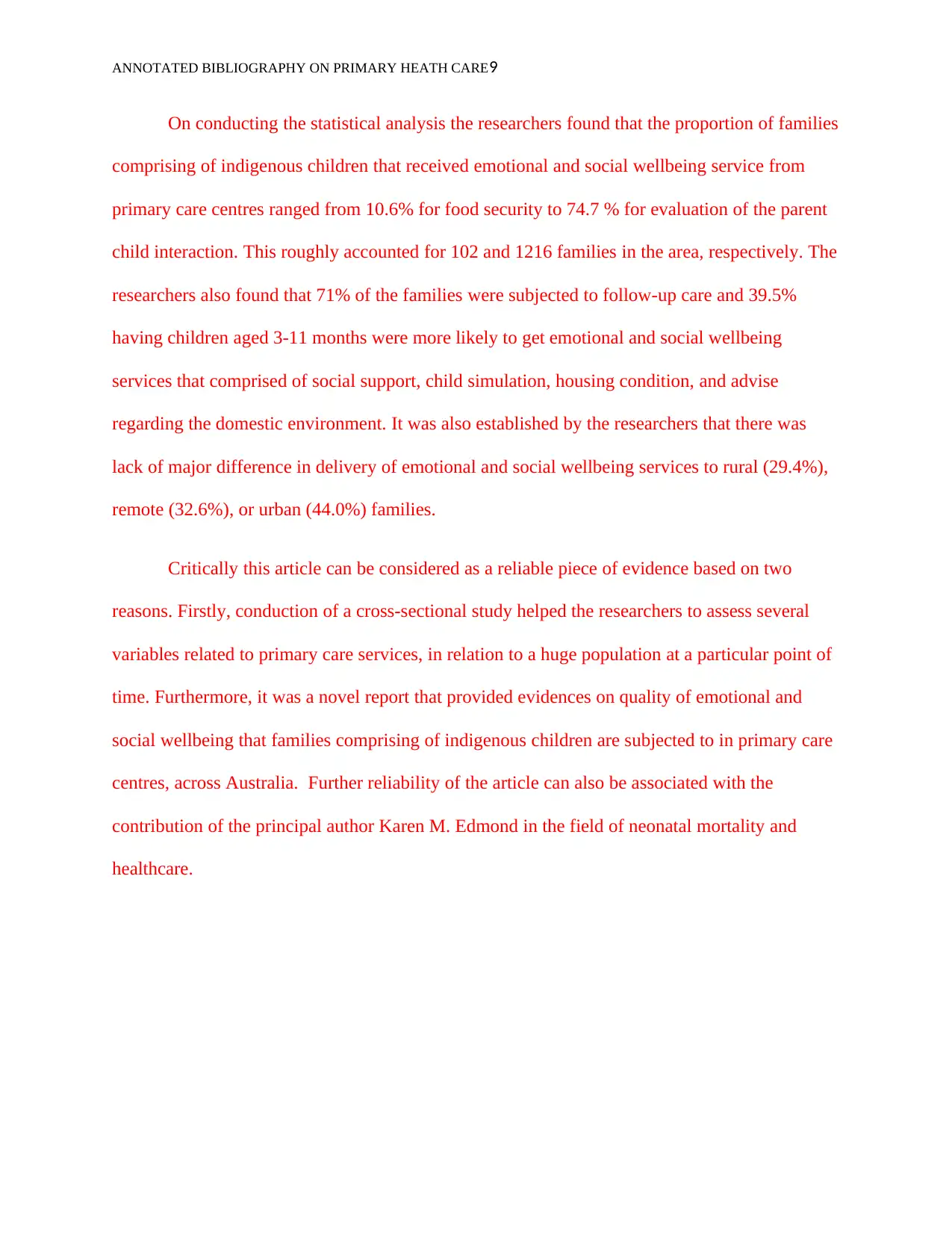
ANNOTATED BIBLIOGRAPHY ON PRIMARY HEATH CARE9
On conducting the statistical analysis the researchers found that the proportion of families
comprising of indigenous children that received emotional and social wellbeing service from
primary care centres ranged from 10.6% for food security to 74.7 % for evaluation of the parent
child interaction. This roughly accounted for 102 and 1216 families in the area, respectively. The
researchers also found that 71% of the families were subjected to follow-up care and 39.5%
having children aged 3-11 months were more likely to get emotional and social wellbeing
services that comprised of social support, child simulation, housing condition, and advise
regarding the domestic environment. It was also established by the researchers that there was
lack of major difference in delivery of emotional and social wellbeing services to rural (29.4%),
remote (32.6%), or urban (44.0%) families.
Critically this article can be considered as a reliable piece of evidence based on two
reasons. Firstly, conduction of a cross-sectional study helped the researchers to assess several
variables related to primary care services, in relation to a huge population at a particular point of
time. Furthermore, it was a novel report that provided evidences on quality of emotional and
social wellbeing that families comprising of indigenous children are subjected to in primary care
centres, across Australia. Further reliability of the article can also be associated with the
contribution of the principal author Karen M. Edmond in the field of neonatal mortality and
healthcare.
On conducting the statistical analysis the researchers found that the proportion of families
comprising of indigenous children that received emotional and social wellbeing service from
primary care centres ranged from 10.6% for food security to 74.7 % for evaluation of the parent
child interaction. This roughly accounted for 102 and 1216 families in the area, respectively. The
researchers also found that 71% of the families were subjected to follow-up care and 39.5%
having children aged 3-11 months were more likely to get emotional and social wellbeing
services that comprised of social support, child simulation, housing condition, and advise
regarding the domestic environment. It was also established by the researchers that there was
lack of major difference in delivery of emotional and social wellbeing services to rural (29.4%),
remote (32.6%), or urban (44.0%) families.
Critically this article can be considered as a reliable piece of evidence based on two
reasons. Firstly, conduction of a cross-sectional study helped the researchers to assess several
variables related to primary care services, in relation to a huge population at a particular point of
time. Furthermore, it was a novel report that provided evidences on quality of emotional and
social wellbeing that families comprising of indigenous children are subjected to in primary care
centres, across Australia. Further reliability of the article can also be associated with the
contribution of the principal author Karen M. Edmond in the field of neonatal mortality and
healthcare.
⊘ This is a preview!⊘
Do you want full access?
Subscribe today to unlock all pages.

Trusted by 1+ million students worldwide
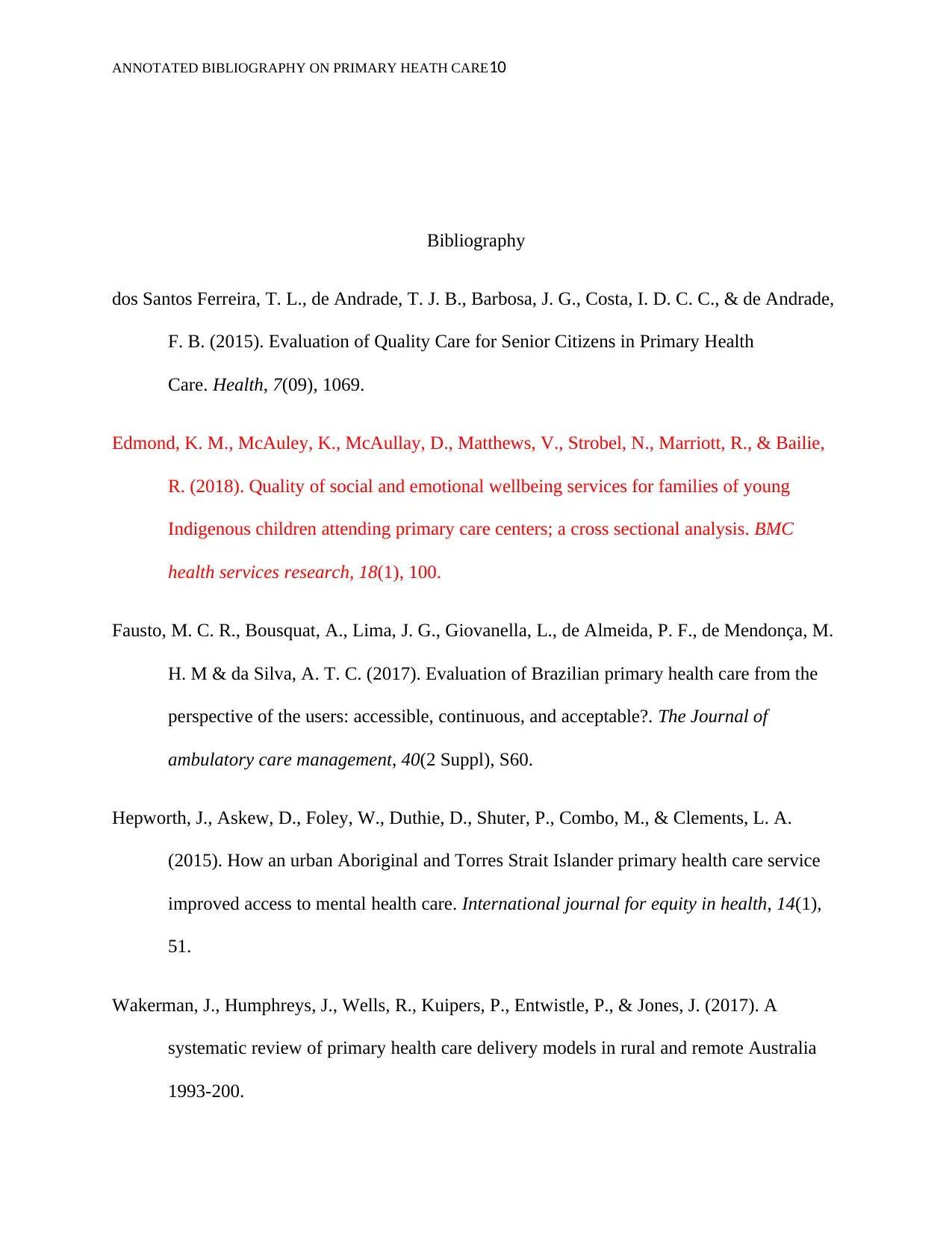
ANNOTATED BIBLIOGRAPHY ON PRIMARY HEATH CARE10
Bibliography
dos Santos Ferreira, T. L., de Andrade, T. J. B., Barbosa, J. G., Costa, I. D. C. C., & de Andrade,
F. B. (2015). Evaluation of Quality Care for Senior Citizens in Primary Health
Care. Health, 7(09), 1069.
Edmond, K. M., McAuley, K., McAullay, D., Matthews, V., Strobel, N., Marriott, R., & Bailie,
R. (2018). Quality of social and emotional wellbeing services for families of young
Indigenous children attending primary care centers; a cross sectional analysis. BMC
health services research, 18(1), 100.
Fausto, M. C. R., Bousquat, A., Lima, J. G., Giovanella, L., de Almeida, P. F., de Mendonça, M.
H. M & da Silva, A. T. C. (2017). Evaluation of Brazilian primary health care from the
perspective of the users: accessible, continuous, and acceptable?. The Journal of
ambulatory care management, 40(2 Suppl), S60.
Hepworth, J., Askew, D., Foley, W., Duthie, D., Shuter, P., Combo, M., & Clements, L. A.
(2015). How an urban Aboriginal and Torres Strait Islander primary health care service
improved access to mental health care. International journal for equity in health, 14(1),
51.
Wakerman, J., Humphreys, J., Wells, R., Kuipers, P., Entwistle, P., & Jones, J. (2017). A
systematic review of primary health care delivery models in rural and remote Australia
1993-200.
Bibliography
dos Santos Ferreira, T. L., de Andrade, T. J. B., Barbosa, J. G., Costa, I. D. C. C., & de Andrade,
F. B. (2015). Evaluation of Quality Care for Senior Citizens in Primary Health
Care. Health, 7(09), 1069.
Edmond, K. M., McAuley, K., McAullay, D., Matthews, V., Strobel, N., Marriott, R., & Bailie,
R. (2018). Quality of social and emotional wellbeing services for families of young
Indigenous children attending primary care centers; a cross sectional analysis. BMC
health services research, 18(1), 100.
Fausto, M. C. R., Bousquat, A., Lima, J. G., Giovanella, L., de Almeida, P. F., de Mendonça, M.
H. M & da Silva, A. T. C. (2017). Evaluation of Brazilian primary health care from the
perspective of the users: accessible, continuous, and acceptable?. The Journal of
ambulatory care management, 40(2 Suppl), S60.
Hepworth, J., Askew, D., Foley, W., Duthie, D., Shuter, P., Combo, M., & Clements, L. A.
(2015). How an urban Aboriginal and Torres Strait Islander primary health care service
improved access to mental health care. International journal for equity in health, 14(1),
51.
Wakerman, J., Humphreys, J., Wells, R., Kuipers, P., Entwistle, P., & Jones, J. (2017). A
systematic review of primary health care delivery models in rural and remote Australia
1993-200.
Paraphrase This Document
Need a fresh take? Get an instant paraphrase of this document with our AI Paraphraser

ANNOTATED BIBLIOGRAPHY ON PRIMARY HEATH CARE11
1 out of 11
Your All-in-One AI-Powered Toolkit for Academic Success.
+13062052269
info@desklib.com
Available 24*7 on WhatsApp / Email
![[object Object]](/_next/static/media/star-bottom.7253800d.svg)
Unlock your academic potential
Copyright © 2020–2025 A2Z Services. All Rights Reserved. Developed and managed by ZUCOL.


